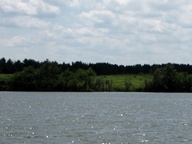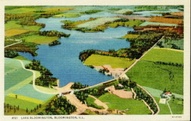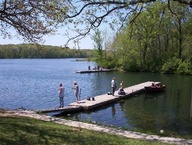In the world of fishing, there's a lot to know. This guide will help you get better results with fishing in Bloomington-Normal. If you aren't an experienced fisher, the information below on the types of fish will be a huge help. If you're planning on fishing in town, the best two public spots would be Lake Bloomington and Evergreen Lake. All the fish listed below you will find in both places. Remember when you're fishing, it's not how many casts you throw but how many fish you catch. Enjoy this fishing guide; hopefully it helps make you a better fisherman.
Fishing Spots
Evergreen Lake
Location: 13001 Recreation Area Drv. Hudson, Illinois 61748
 Evergreen Lake is a 900 acre, fresh water lake ten miles north of Bloomington. It's known for great fishing, boating, water sports, camping, hiking and swimming. Canoes, paddleboats, rowboats, kayaks, and 5 horsepower outboard motors are available for renting. State record Walleye, Muskie, Crappie, and Bass make this a favorite fishing spot. This is a very popular place for tournament fishing. The lake has docks, several fishing piers, and a bait shop. There are a variety of fish. However there are regulations for catch and release fishing. You must have a valid fishing license and there is a maximum 10 horsepower motor limit.
Evergreen Lake is a 900 acre, fresh water lake ten miles north of Bloomington. It's known for great fishing, boating, water sports, camping, hiking and swimming. Canoes, paddleboats, rowboats, kayaks, and 5 horsepower outboard motors are available for renting. State record Walleye, Muskie, Crappie, and Bass make this a favorite fishing spot. This is a very popular place for tournament fishing. The lake has docks, several fishing piers, and a bait shop. There are a variety of fish. However there are regulations for catch and release fishing. You must have a valid fishing license and there is a maximum 10 horsepower motor limit.
Surface Acres: 900 acres
Maximum Depth: 55 feet
Average Depth: 19 feet
Shoreline Miles: 22.5 miles
http://www.co.mclean.il.us/parks/fishing.htm
Lake Bloomington
Location: 15 miles North of Bloomington (2500N) 4 miles Illinois 61748
 Lake Bloomington is a 635 acre, fresh water lake fifteen miles north of Bloomington. There are several activities that Lake Bloomington has to offer such as boating, fishing, hiking, swimming, water sports and camping. There are park areas in various locations around the lake. Picnic tables, shelters, grills, and playgrounds are all available for anyone to use. Park areas are open from 6am to 10pm daily. This lake is known for having great fishing because of seasonal fish stocking and the catch and release policy. Walleye, Largemouth Bass, Smallmouth Bass, Northern Pike, Crappie, Bluegill, and Catfish can all be caught in Lake Bloomington. Lake Bloomington has a strict catch and release policy. Anyone 16 years of age or older must have a fishing license. If using a boat, there is a maximum 40 horsepower motor limit. Lake Bloomington also has a local business called Green Gables located West of it that you can buy fishing accessories at, and get a great burger.
Lake Bloomington is a 635 acre, fresh water lake fifteen miles north of Bloomington. There are several activities that Lake Bloomington has to offer such as boating, fishing, hiking, swimming, water sports and camping. There are park areas in various locations around the lake. Picnic tables, shelters, grills, and playgrounds are all available for anyone to use. Park areas are open from 6am to 10pm daily. This lake is known for having great fishing because of seasonal fish stocking and the catch and release policy. Walleye, Largemouth Bass, Smallmouth Bass, Northern Pike, Crappie, Bluegill, and Catfish can all be caught in Lake Bloomington. Lake Bloomington has a strict catch and release policy. Anyone 16 years of age or older must have a fishing license. If using a boat, there is a maximum 40 horsepower motor limit. Lake Bloomington also has a local business called Green Gables located West of it that you can buy fishing accessories at, and get a great burger.
http://www.lakebloomington.com
Types of Local Fish
LargeMouth Bass
 LargeMouth Bass are typically green with dark spots that form a stripe along the middle of the fish on either side. There upper jaw reaches far beyond the rear margin of the eye. The size of the mouth is a noticeable feature that distinguishes the LargeMouth Bass from the SmallMouth Bass. Commonly found in large clear-water lakes or ponds. Most typically expected to be .5 lbs to 10 lbs. Can be heavier. They will be mostly found by stumps, logs, brush, weeds and boat docks. Bass also have good color vision, and get interested in objects that move fairly quickly so good live baits to use would be crawdads, minnows and worms.
LargeMouth Bass are typically green with dark spots that form a stripe along the middle of the fish on either side. There upper jaw reaches far beyond the rear margin of the eye. The size of the mouth is a noticeable feature that distinguishes the LargeMouth Bass from the SmallMouth Bass. Commonly found in large clear-water lakes or ponds. Most typically expected to be .5 lbs to 10 lbs. Can be heavier. They will be mostly found by stumps, logs, brush, weeds and boat docks. Bass also have good color vision, and get interested in objects that move fairly quickly so good live baits to use would be crawdads, minnows and worms.
SmallMouth Bass
 SmallMouth Bass are typically green with dark vertical bands along the side. Their upper jaw never extends beyond the eye. Compared to the Largmouth Bass, the Smallmouth Bass will be skinner in width and usually smaller in length. Most commonly found in large clear-water lakes or ponds. However they prefer a different hiding area than their Largemouth cousins, Smallmouth tend to be near rocks, logs, and debris. Typically expected to be .5lbs to 5lbs. Maximum size would be roughly 8lbs. Good live bait to use would be crawdads, minnows and worms. Lures can also be used with all bass, but fake bait requires more technique and can be much harder to get results from. Bass rely on smell, not sight. If you are more experienced, use lures. You can get bigger fish that way, however if you are not as experienced stick to live bait because fish will be attracted to that more.
SmallMouth Bass are typically green with dark vertical bands along the side. Their upper jaw never extends beyond the eye. Compared to the Largmouth Bass, the Smallmouth Bass will be skinner in width and usually smaller in length. Most commonly found in large clear-water lakes or ponds. However they prefer a different hiding area than their Largemouth cousins, Smallmouth tend to be near rocks, logs, and debris. Typically expected to be .5lbs to 5lbs. Maximum size would be roughly 8lbs. Good live bait to use would be crawdads, minnows and worms. Lures can also be used with all bass, but fake bait requires more technique and can be much harder to get results from. Bass rely on smell, not sight. If you are more experienced, use lures. You can get bigger fish that way, however if you are not as experienced stick to live bait because fish will be attracted to that more.
Muskie
 Muskie are typically grey, brown in color with horizontal spots covering the entire body. They are mostly distinguished by their long flat head and razor like teeth. This is one of the more dangerous fish to catch. Muskie are typically 28–48 inches in length and rang in weight from 5lbs to 36lbs. They can get bigger. Muskies are known for eating anything that will fit in its mouth. Use live bait such as cut up fish, frogs and crawfish to attract them. Their bite will be hard and fast. They attack prey head first so you will know when you've caught one.
Muskie are typically grey, brown in color with horizontal spots covering the entire body. They are mostly distinguished by their long flat head and razor like teeth. This is one of the more dangerous fish to catch. Muskie are typically 28–48 inches in length and rang in weight from 5lbs to 36lbs. They can get bigger. Muskies are known for eating anything that will fit in its mouth. Use live bait such as cut up fish, frogs and crawfish to attract them. Their bite will be hard and fast. They attack prey head first so you will know when you've caught one.
Catfish
The most common catfish that will be seen in this area are Flathead Catfish and Channel Catfish. Catfish can be very powerful fish. They tend to live in areas of heavy cover so it will take time to lure them towards bait. Catfish are also bottom feeders so it is best to use sinkers or heavy weighted bait. Catfish eat day or night. The best bait to use is live bait like shad or smaller fish cut up. They use their sense of smell to feed so the stronger your bait smells, the better chance you have of catching catfish.
 Flathead Catfish is distinguishable by its flat head. It has smooth, scaleless skin, whisker-like barbels around the mouth and long sharp spines on the dorsal fin. Reach a length of 3 to 4 feet and their weight can exceed 100lbs. The smaller the catfish are, the darker in color they will be. Will be caught in cloudy, slow current lakes, rivers or ponds.
Flathead Catfish is distinguishable by its flat head. It has smooth, scaleless skin, whisker-like barbels around the mouth and long sharp spines on the dorsal fin. Reach a length of 3 to 4 feet and their weight can exceed 100lbs. The smaller the catfish are, the darker in color they will be. Will be caught in cloudy, slow current lakes, rivers or ponds.
 Channel Catfish are easily distinguishable. Unlike flathead catfish, the upper jaw projects beyond the lower jaw. Usually olive-brown to blue in color. Most adult channel catfish will reach roughly 2 to 3 feet in length. Their weight can exceed 50lbs but will typically by under 30lbs. Will be caught in cloudy streams or lakes with a low current.
Channel Catfish are easily distinguishable. Unlike flathead catfish, the upper jaw projects beyond the lower jaw. Usually olive-brown to blue in color. Most adult channel catfish will reach roughly 2 to 3 feet in length. Their weight can exceed 50lbs but will typically by under 30lbs. Will be caught in cloudy streams or lakes with a low current.
Bluegill
 Bluegill have a dark spot at the base of the dorsal fin, vertical bars on their sides and a relatively small mouth. The dark spot distinguishes them from other types of sunfish. Their weight can range from less than .5lb to 4lbs. If caught, they will most likely be under 2lbs. Commonly found in large clear-water lakes or ponds. The best bait to use would be live bait such as worms, crawdads and minnows Bluegill have a very specific type of bite. After casting you will either feel a yank (which is not a bluegill) or multiple little bites. Bluegill do not attack bait, they tend to bite pieces out of it. This will let you know if you have a bluegill on your line.
Bluegill have a dark spot at the base of the dorsal fin, vertical bars on their sides and a relatively small mouth. The dark spot distinguishes them from other types of sunfish. Their weight can range from less than .5lb to 4lbs. If caught, they will most likely be under 2lbs. Commonly found in large clear-water lakes or ponds. The best bait to use would be live bait such as worms, crawdads and minnows Bluegill have a very specific type of bite. After casting you will either feel a yank (which is not a bluegill) or multiple little bites. Bluegill do not attack bait, they tend to bite pieces out of it. This will let you know if you have a bluegill on your line.
Sunfish
 There are many types of Sunfish that will be seen in this area. However they are all very similar. Sunfish range from dark olive to almost white in color with yellow to orange sides. The most distinct characteristic would be the red/orange edge on the ear. Their weight can range from less then .5lbs to 3lbs. Will typically be smaller than Bluegill. Commonly found in large fresh-water lakes or ponds. Like Bluegill, Sunfish have a very specific bite. When using live bait they tend to bite little pieces, instead of swallowing the bait. It is an easy way to distinguish the type of fish you hook.
There are many types of Sunfish that will be seen in this area. However they are all very similar. Sunfish range from dark olive to almost white in color with yellow to orange sides. The most distinct characteristic would be the red/orange edge on the ear. Their weight can range from less then .5lbs to 3lbs. Will typically be smaller than Bluegill. Commonly found in large fresh-water lakes or ponds. Like Bluegill, Sunfish have a very specific bite. When using live bait they tend to bite little pieces, instead of swallowing the bait. It is an easy way to distinguish the type of fish you hook.
Crappie
 Crappie are typically silver in color, ranging from silver-white to a silver-green or even dark green. There are several vertical bars on the sides. Their weight can range from less than .5lbs to 4lbs. Typically bigger than other types of sunfish. Commonly found in large fresh-water lakes or ponds. They most resemble bluegill and sunfish. Good live baits to use would be crawdads, minnows and worms. Their bite is similar to sunfish and bluegills. They will bite little pieces off instead of swallowing the bait.
Crappie are typically silver in color, ranging from silver-white to a silver-green or even dark green. There are several vertical bars on the sides. Their weight can range from less than .5lbs to 4lbs. Typically bigger than other types of sunfish. Commonly found in large fresh-water lakes or ponds. They most resemble bluegill and sunfish. Good live baits to use would be crawdads, minnows and worms. Their bite is similar to sunfish and bluegills. They will bite little pieces off instead of swallowing the bait.



